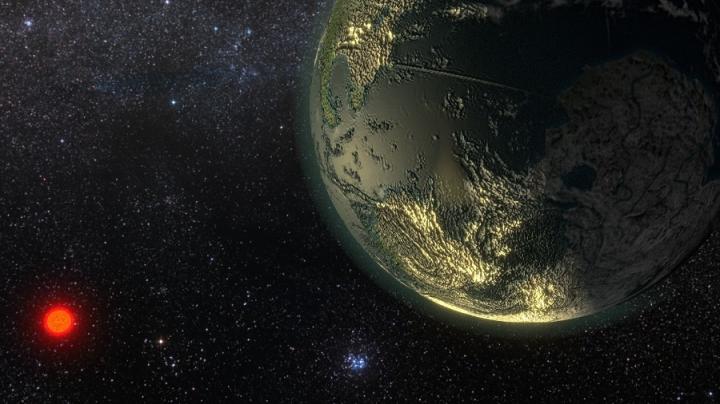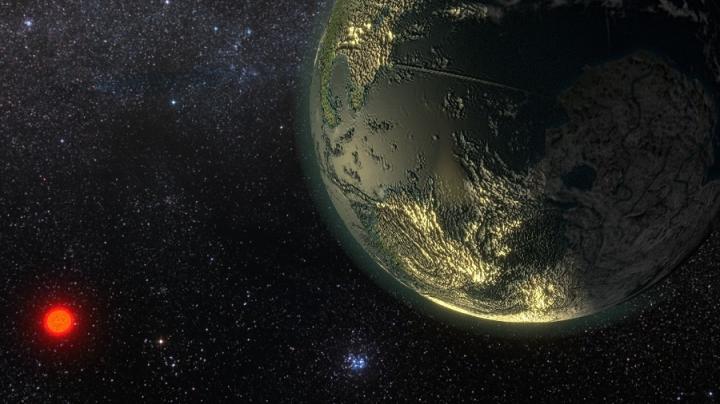
Credit: courtesy of Ricardo Ramirez.
Washington, DC — An international team of astronomers released the largest-ever compilation of exoplanet-detecting observations made using a technique called the radial velocity method. They demonstrated how these observations can be used to hunt for planets by detecting more than 100 potential exoplanets, including one orbiting the fourth-closest star to our own Solar System, which is about 8.1 light years away from Earth. The paper is published in The Astronomical Journal.
The radial velocity method is one of the most successful techniques for finding and confirming planets. It takes advantage of the fact that in addition to a planet being influenced by the gravity of the star it orbits, the planet's gravity also affects the star. Astronomers are able to use sophisticated tools to detect the tiny wobble the planet induces as its gravity tugs on the star.
The virtual mountain of data released to the public in this paper was gathered as part of a two-decade radial velocity planet-hunting program that uses a spectrometer called HIRES, mounted on the 10-meter Keck-I telescope of the W.M. Keck Observatory atop Mauna Kea in Hawaii. The compilation includes almost 61,000 individual measurements made of more than 1,600 stars. By making the data public, the team is offering unprecedented access to one of the best exoplanet searches in the world.
"HIRES was not specifically optimized to do this type of exoplanet detective work, but has turned out to be a workhorse instrument of the field", said Steve Vogt of the University of California Santa Cruz, who built the instrument. "I am very happy to contribute to science that is fundamentally changing how we view ourselves in the universe."
Now as the survey moves into its third decade, the team members have decided it is time to clean house. With so much data at hand and a limited amount of time, they recognized that more exoplanets would be found by sharing their catalog with the exoplanet community.
But the team is not just giving everyone the keys to their exoplanet-finder; they are also taking it out for a spin themselves. Mikko Tuomi of the University of Hertfordshire led a sophisticated statistical analysis of the large data set to tease out the periodic signals most likely to be planets.
"We were very conservative in this paper about what counts as an exoplanet candidate and what does not," Tuomi explained, "and even with our stringent criteria, we found over 100 new likely planet candidates."
One of these probable planets is around a star called GJ 411, also known as Lalande 21185. It is the fourth-closest star to our own Sun and is only about 40 percent the mass of the Sun. The planet has a very short orbital period of just under 10 days, so it is no Earth-twin. However, the inferred [not sure about this word choice] planet, GJ 411b, continues a trend that has been seen in the overall population of detected exoplanets: the smallest planets are found around the smallest stars.
"One of our key goals in this paper is to democratize the search for planets," explained team member Greg Laughlin of Yale. "Anyone can download the velocities published on our website and use the open source Systemic software package and try fitting planets from the data. A tutorial on how to use Systemic will be available."
The team is hoping their decision will lead to a flurry of new science, as astronomers around the globe combine the HIRES data with their own existing observations, or mount new observing campaigns to follow up on potential signals. The catalog release is part of a growing trend in exoplanet science to broaden the audience and discovery space, which has emerged in part to handle the aftermath offollow-up discoveries by NASA's Kepler and K2 missions.
"I think this paper sets a precedent for how the community can collaborate on exoplanet detection and follow-up", said team-member Johanna Teske of Carnegie's Observatories and Department of Terrestrial Magnetism. "With NASA's TESS mission on the horizon, which is expected to detect 1000+ planets orbiting bright, nearby stars, exoplanet scientists will soon have a whole new pool of planets to follow up."
"The best way to advance the field and further our understanding of what these planets are made out of is to harness the abilities of a variety of precision radial velocity instruments, and deploy them in concert," added team member Jennifer Burt of MIT. "But that will require some big teams to break from tradition and start leading serious cooperative efforts."
And from Carnegie's Paul Butler, the paper's lead author and the man who helped jumpstart the field of exoplanet science: "This paper and data release represents a good chunk of my life work."
###
Media Contact
Paul Butler
[email protected]
202-478-8866
@carnegiescience
https://carnegiescience.edu/
############
Story Source: Materials provided by Scienmag





